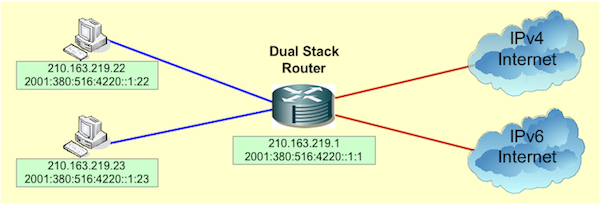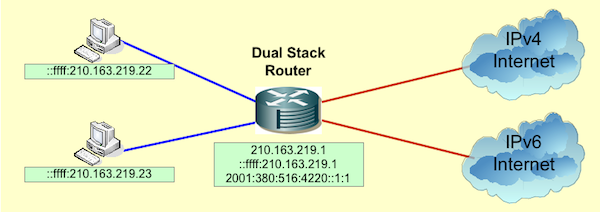Transition Strategies
Current Systems
Current information systems generally support the IPv6. Most personal computers, mobile devices, and networking equipment support IPv6 by default. Nevertheless Implementing IPv6 on a network involves overcoming many challenges, any of which limit deployment of the new protocol.
- IPv6 Availability. There are very few ISPs that offer IPv6 services.
- IPv6 Accessibility. Most of the internet is only connected over IPv4, and is inaccessible to systems with only an IPv6 connection.
- IPv6 Resolvability. Most of the Internet's root DNS servers are only accessible over IPv4.
- IPv6 Support. Some major applications, e.g., Microsoft Exchange 2010 will not function in a pure IPv6 environment.
An implementation plan for IPv6 needs to work around each of these constraints, especially in the case involving the transition to IPv6 for an existing network infrastructure. There are several popular transition strategies.
Dual IP Stack

Dual IP Stack is most obvious and flexible transition strategy and simply involves installing both IPv4 and IPv6 on systems that are capable of running both. As we noted previously, the IPv6 protocol is independent of IPv4; a system with only an IPv6 address cannot directly communicate with a system with only an IPv4 address and vice versa. In order to be able to directly communicate with either another IPv4 or IPv6 system, a system needs to have both an IPv4 and an IPv6 address, since the protocols do not interoperate. This independence allows IPv6 addresses and protocols to be used in parallel with any existing IPv4 addresses and routing.
The Dual IP Stack strategy allows hosts to access services over either the IPv4 or IPv6 internet, provided that their network is connected with both IPv4 and IPv6 Wide Area Networks (WANs). Even without an IPv6 WAN connection, the Dual IP Stack strategy IPv6 can be installed internally on a network, while still using only IPv4 for its Wide Area Network (WAN).
Tunneling

Tunneling solves the IPv6 WAN problem by encapsulating IPv6 packets within IPv4 packets to connect to the IPv6 routed Internet. The Tunneling strategy provides a solution for networks whose ISPs do not offer IPv6 routing. Tunneling services require a remote Tunnel Broker to route the tunneled traffic. The direct encapsulation of IPv6 datagrams within IPv4 packets is supported by its own standard IP protocol, supported by all networking equipment.
IPv4-Mapped IPv6

There is also a hybrid strategy using a special dual-stack IPv6/IPv4 implementation that combines the IPv4 and IPv6 addresses using a special class of addresses, the IPv4-mapped IPv6 strategy. Within this strategy, a special address type is used where the first 80 bits of the address are set to zero, the next 16 are set to one, and last 32 bits are filled with the IPv4 address. These addresses are commonly represented in the standard IPv6 format, except that the last 32 bits are written in the customary dot-decimal notation of IPv4; for example,
::ffff:192.0.2.128
is an IPv6 representation of the IPv4 address:
192.0.2.128.
IPv4 address embedding is used to create a relationship between an IPv4 address and an IPv6 address to aid in the transition from IPv4 to IPv6. This strategy is applicable to an internal implementation and reduces the complexity of a standard Dual Stack implementation.







